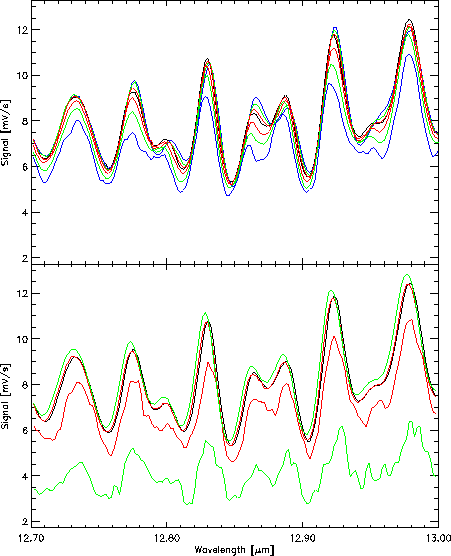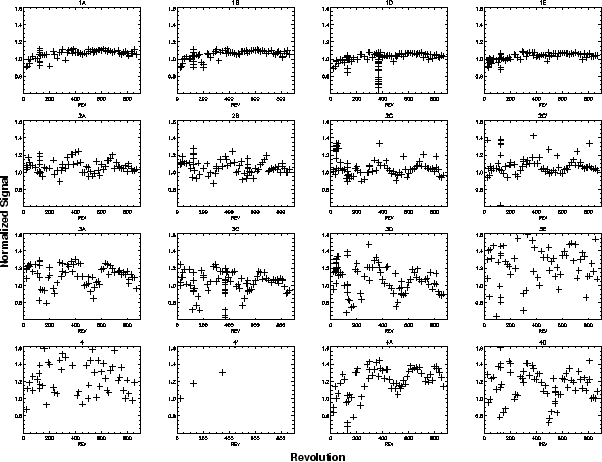The SWS was designed for a pointing performance consistent with the specification of the telescope optics, but exceeding the specifications of the ISO satellite. Fortunately the satellite pointing was significantly better than specified. Nevertheless, for SWS the data quality was affected by the ISO pointing performance and further improvements on the pointing were triggered by these findings. Even then, pointing problems have remained a limitation for many SWS observations.
The accuracy of the target input coordinates, and of the pointing, have
a large impact on the instrumental throughput and the point source flux
accuracy, but only a minor impact on the wavelength accuracy of SWS for
point sources. Several documents were written covering the pointing accuracy.
Leech & Heras 1997, [26], gives examples of what can go
wrong when incorrect target coordinates are used. In summary, a star
offset from the centre of the aperture by 6
![]() in the
cross-dispersion direction (y-axis) loses
approximately 40% in throughput (at 17
in the
cross-dispersion direction (y-axis) loses
approximately 40% in throughput (at 17 ![]() m).
A similar offset in the dispersion
direction (z-axis) does not result in as large a flux decrease, due to
the beam profile (see Section 8.4). An offset in the
dispersion direction does, however, affect the wavelength calibration,
with a 4
m).
A similar offset in the dispersion
direction (z-axis) does not result in as large a flux decrease, due to
the beam profile (see Section 8.4). An offset in the
dispersion direction does, however, affect the wavelength calibration,
with a 4
![]() mispointing resulting in a 1 LVDT (1/8
grating resolution) wavelength offset. As the maximum possible offset
is about 2 LVDT, or about
mispointing resulting in a 1 LVDT (1/8
grating resolution) wavelength offset. As the maximum possible offset
is about 2 LVDT, or about ![]() of a grating spectral
resolution element, and within the required wavelength accuracy, errors
introduced into the wavelength scale can usually be ignored. Still,
random pointing errors are the largest contributors of uncertainty in
the wavelength scale. They also impact on the exact fringe patterns, see
fringes in Sections 8.6.2 and 9.7.
of a grating spectral
resolution element, and within the required wavelength accuracy, errors
introduced into the wavelength scale can usually be ignored. Still,
random pointing errors are the largest contributors of uncertainty in
the wavelength scale. They also impact on the exact fringe patterns, see
fringes in Sections 8.6.2 and 9.7.
Heras 1998, [14] extended this study by comparing
the ratio of
on- and off-source observations of a star with
the pointing jitter. It was found that the sudden flux jumps are associated
with pointing fluctuations. She noted that even for nominally
on-source observations (defined to be those where the pointing error is
less than about 4
![]() ), there is a correlation between
noise in an observation and pointing jitter.
), there is a correlation between
noise in an observation and pointing jitter.
During the ISO mission several stars were observed every few weeks for
purposes of wavelength and flux calibration. The flux of one of these
targets, ![]() Dra, was seen to have a modulation that is
suspected to be due to pointing errors. The report by Feuchtgruber 1998c,
[8], can be read for further information on this.
Dra, was seen to have a modulation that is
suspected to be due to pointing errors. The report by Feuchtgruber 1998c,
[8], can be read for further information on this.
Information on how the spacecraft pointing can affect observations of extended objects can be read in Feuchtgruber 1998b, [7]. In this case the observed line fluxes varied by 10% over the course of several months. This was attributed to the spatial extent of NGC 6543, the SWS slit size projected on the sky, see Section 8.2.2, and the change in roll angle between the observations.
To derive the position angle of an aperture, information on the spacecraft's position on the sky must be used. This can be found in the header keywords CINSTRA, CINSTDEC, CINSTROLL in ERD, SPD, or AAR products. (see the ISO Handbook Volume I, [17] for a description of these keywords).
The effect of pointing offsets on the position and intensity of the instrumental fringes, most prominent in band 3A, was characterised with dedicated spectral scans performed at various positions with respect to NML Cyg as illustrated in Figure 8.7. The dependence of the fringe pattern on the pointing also implies that for extended sources or point-like sources off-axis, a perfect correction for the instrumental response function is not possible.

|
The ISO pointing jitter is seen by the SWS
detectors as the target moves across the beam profile, and results in
correlated noise in the band.
This correlated
noise is discussed in Heras 1998, [14], where
the correlation between ISO's pointing jitter and jumps in the flux of
SWS observations were first studied. The source DO 24107 was observed
off source because of an error in the input coordinates
(![]() 4.7
4.7
![]() and
and ![]() 8.6
8.6
![]() off in dispersion and
cross-dispersion directions respectively). Such a large discrepancy
implies that the observation is carried out at a position where the
beam profile is very steep, and therefore small oscillations of the
pointing around the average position induce large variations of the
measured flux.
off in dispersion and
cross-dispersion directions respectively). Such a large discrepancy
implies that the observation is carried out at a position where the
beam profile is very steep, and therefore small oscillations of the
pointing around the average position induce large variations of the
measured flux.
The SWS flux calibration included reproducibility checks on the standard
star ![]() Dra. A total of 120 observations were
carried out on this star from revolution 24 to revolution 867. These
were systematically processed at the end of the mission and
the resulting signals were shown to present flux modulations over the
mission (see Feuchtgruber 1998c, [8], for details). Figure
8.8 gives all the derived fluxes within the passbands
of the related band versus revolution. The three
Dra. A total of 120 observations were
carried out on this star from revolution 24 to revolution 867. These
were systematically processed at the end of the mission and
the resulting signals were shown to present flux modulations over the
mission (see Feuchtgruber 1998c, [8], for details). Figure
8.8 gives all the derived fluxes within the passbands
of the related band versus revolution. The three ![]() -Dra raster
exercises in revolutions 126, 368 and 369 are also included in this
sample, clearly to be seen for example in band 1D.
-Dra raster
exercises in revolutions 126, 368 and 369 are also included in this
sample, clearly to be seen for example in band 1D.
Flux modulations can clearly be seen at the key wavelengths in bands
2A, 2B, 2C, 2C![]() (at 11
(at 11 ![]() m),
3A, 3C, 3D, 3E,
4A (offband data) and 4D (offband data).
No related modulation of comparable amplitude can be seen in band 1.
Fluxes are heavily affected by
pointing inaccuracies, as can be seen in the period before revolution
369, when significant pointing errors happened. Also the use of
different guide stars with different accuracies are suspected of
introducing additional noise in the flux trends. The best explanation
for the flux modulation, still unproven however, is a systematic
pointing error towards
m),
3A, 3C, 3D, 3E,
4A (offband data) and 4D (offband data).
No related modulation of comparable amplitude can be seen in band 1.
Fluxes are heavily affected by
pointing inaccuracies, as can be seen in the period before revolution
369, when significant pointing errors happened. Also the use of
different guide stars with different accuracies are suspected of
introducing additional noise in the flux trends. The best explanation
for the flux modulation, still unproven however, is a systematic
pointing error towards ![]() Dra. Band 1 has basically 0 FPG offset, while
all the other bands are offset by
2
Dra. Band 1 has basically 0 FPG offset, while
all the other bands are offset by
2
![]()
![]() 3
3
![]() . This makes bands 2, 3 and 4
sensitive to even small ( 1
. This makes bands 2, 3 and 4
sensitive to even small ( 1
![]() ) pointing errors, as they
are operated close to the edge of the flat top of the SWS beam profile.
Begin centred, band 1 remains rather robust against pointing errors.
) pointing errors, as they
are operated close to the edge of the flat top of the SWS beam profile.
Begin centred, band 1 remains rather robust against pointing errors.

|